HONDA CIVIC COUPE 2012 9.G User Guide
Manufacturer: HONDA, Model Year: 2012, Model line: CIVIC COUPE, Model: HONDA CIVIC COUPE 2012 9.GPages: 33, PDF Size: 2.75 MB
Page 11 of 33
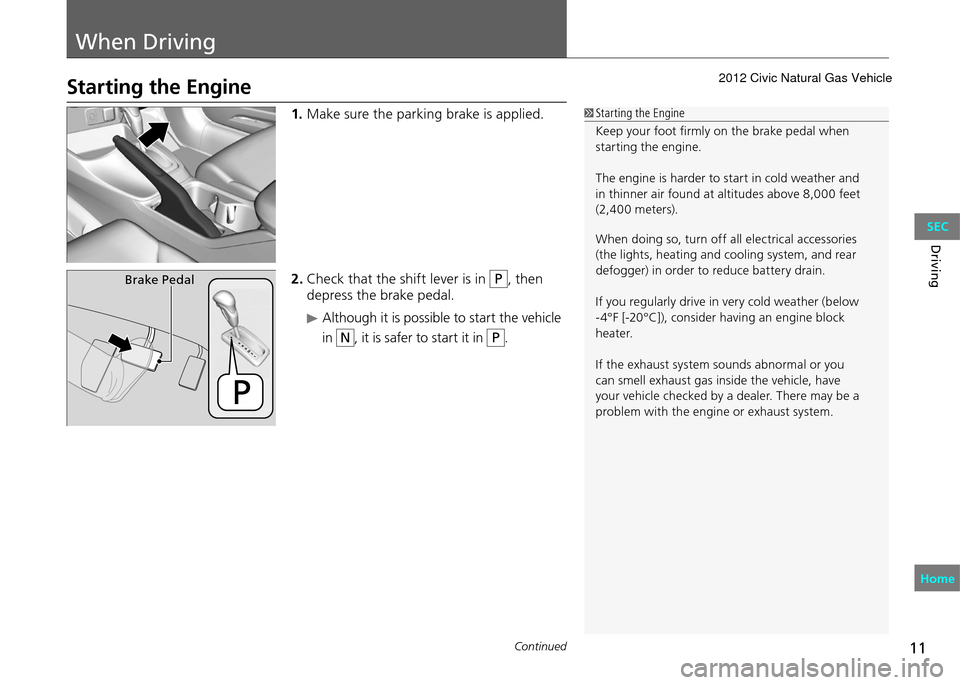
11
When Driving
Continued
Driving
Starting the Engine
Starting the Engine
Keep your foot firmly on the brake pedal when
starting the engine.
The engine is harder to start in cold weather and
in thinner air found at altitudes above 8,000 feet
(2,400 meters).
When doing so, turn off all electrical accessories
(the lights, heating and cooling system, and rear
defogger) in order to reduce battery drain.
If you regularly drive in very cold weather (below
-4°F [-20°C]), consider having an engine block
h e a t e r.
If the exhaust system sounds abnormal or you
can smell exhaust gas inside the vehicle, have
your vehicle checked by a dealer. There may be a
problem with the engine or exhaust system.
Brake Pedal
1. Make sure the parking brake is applied.
2. Check that the shift lever is in P
, then
depress the brake pedal.
Although it is possible to start the vehicle
in
N, it is safer to start it in P.
Home SEC
2012 Civic Natural Gas Vehicle
Page 12 of 33
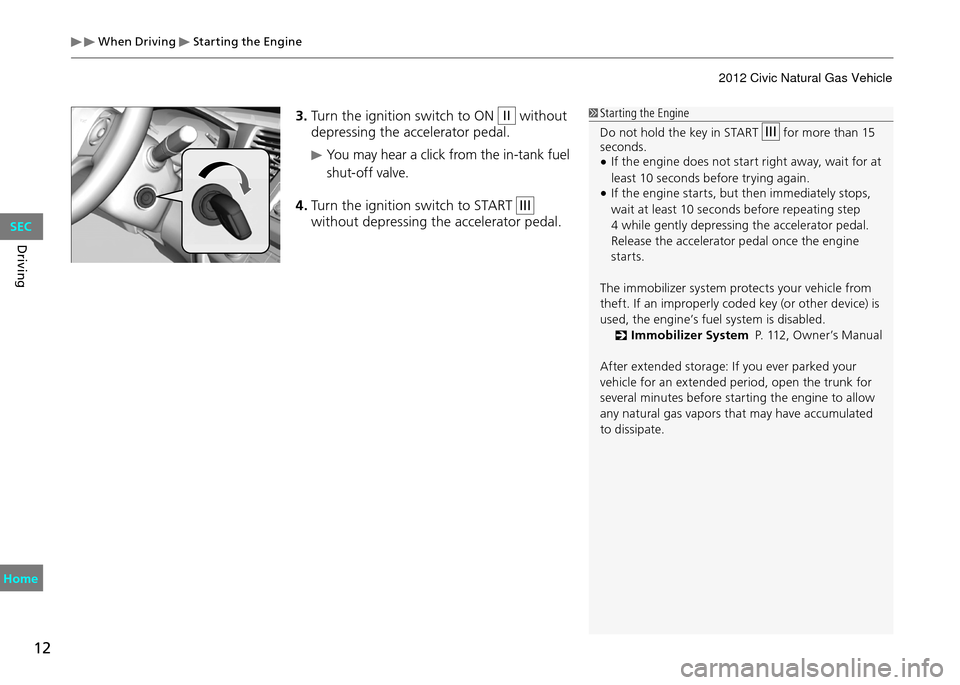
When Driving Starting the Engine
12
Driving
3. Turn the ignition switch to ON II without
depressing the accelerator pedal.
You may hear a click from the in-tank fuel
shut-off valve.
4. Turn the ignition switch to START III
without depressing the accelerator pedal.
Starting the Engine
Do not hold the key in START
III for more than 15
seconds.
If the engine does not start right away, wait for at
•least 10 seconds before trying again.
If the engine starts, but then immediately stops,
•wait at least 10 seconds before repeating step
4 while gently depressing the accelerator pedal.
Release the accelerator pedal once the engine
starts.
The immobilizer system protects your vehicle from
theft. If an improperly coded key (or other device) is
used, the engine’s fuel system is disabled. Immobilizer Syste m
P. 112, Owner’s Manual
After extended storage: If you ever parked your
vehicle for an extended period, open the trunk for
several minutes before starting the engine to allow
any natural gas vapors that may have accumulated
to dissipate.
Home SEC
2012 Civic Natural Gas Vehicle
Page 13 of 33
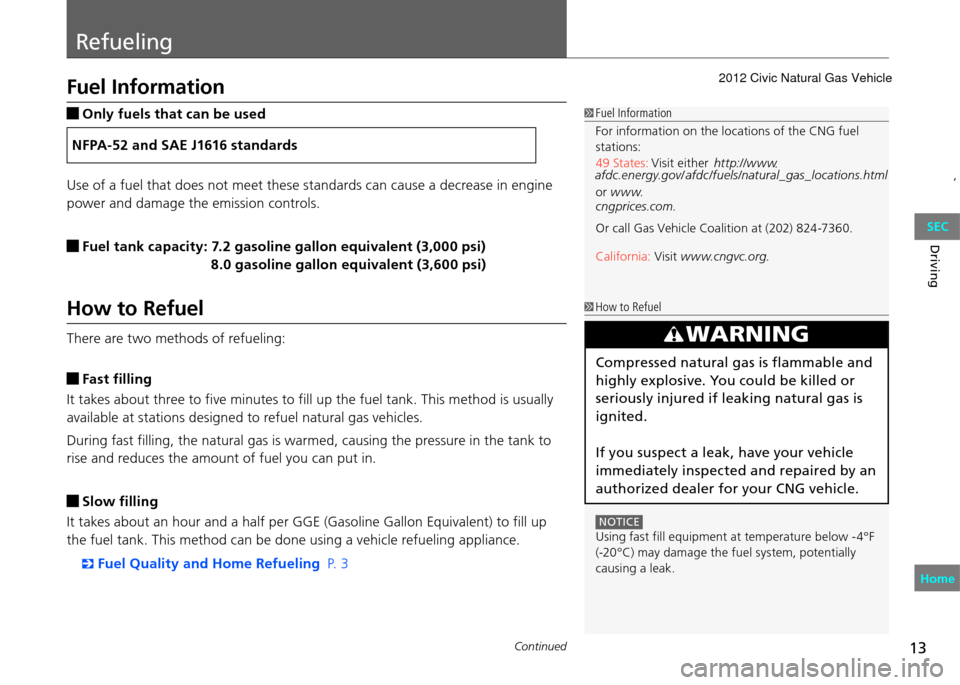
13
Refueling
Continued
Driving
Fuel Information
Only fuels that can be used
NFPA-52 and SAE J1616 standards
Use of a fuel that does not meet these standards can cause a decrease in engine
power and damage the emission controls.
Fuel tank capacity: 7.2 gasoline gallon equivalent (3,000 psi)
8.0 gasoline gallon equivalent (3,600 psi)
How to Refuel
There are two methods of refueling:
Fast filling
It takes about three to five minutes to fill up the fuel tank. This method is usually
available at stations designed to refuel natural gas vehicles.
During fast filling, the natural gas is warmed, causing the pressure in the tank to
rise and reduces the amount of fuel you can put in.
Slow filling
It takes about an hour and a half per GGE (Gasoline Gallon Equivalent) to fill up
the fuel tank. This method can be done using a vehicle refueling appliance.
Fuel Quality and Home Refuelin g
P. 3
Fuel Information
For information on the locations of the CNG fuel
stations:
49 States: Visit either
http://
w w w
.
afdc.energy.gov/ afdc/fuels/natural_gas_ locations.html ,
or
www.
cngprices.com.
Or call Gas Vehicle Coalition at (202) 824-7360.
California: Visit www.cngvc.org.
How to Refuel
WARNING
Compressed natural gas is flammable and
highly explosive. You could be killed or
seriously injured if leaking natural gas is
ignited.
If you suspect a leak, have your vehicle
immediately inspected and repaired by an
authorized dealer for your CNG vehicle.
NOTICE Using fast fill equipment at temperature below -4°F
(-20°C) may damage the fuel system, potentially
causing a leak.
Home SEC
2012 Civic Natural Gas Vehicle
Page 14 of 33
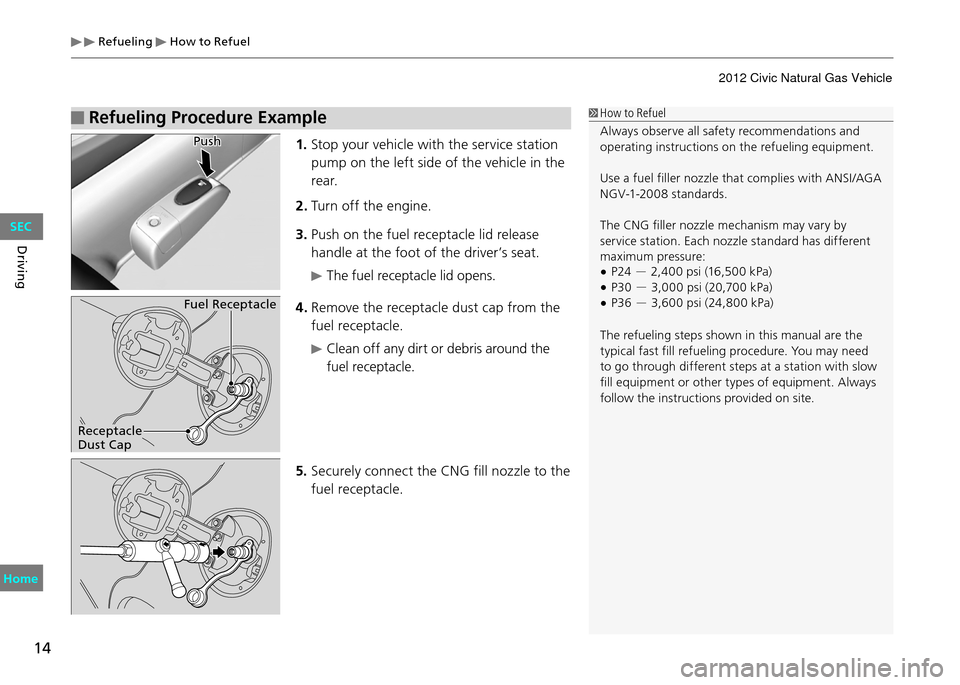
Refueling How to Refuel
14
Driving
Refueling Procedure Example How to Refuel
Always observe all safety recommendations and
operating instructions on the refueling equipment.
Use a fuel filler nozzle that complies with ANSI/AGA
NGV-1-2008 standards.
The CNG filler nozzle mechanism may vary by
service station. Each nozzle standard has different
maximum pressure:P24
•- 2,400 psi (16,500 kPa)
P30
•- 3,000 psi (20,700 kPa)
P36
•- 3,600 psi (24,800 kPa)
The refueling steps shown in this manual are the
typical fast fill refueling procedure. You may need
to go through different steps at a station with slow
fill equipment or other types of equipment. Always
follow the instructions provided on site.
1. Stop your vehicle with the service station
pump on the left side of the vehicle in the
r e a r.
2. Turn off the engine.
3. Push on the fuel receptacle lid release
handle at the foot of the driver’s seat.
The fuel receptacle lid opens.
4. Remove the receptacle dust cap from the
fuel receptacle.
Clean off any dirt or debris around the
fuel receptacle.
5
. Securely connect the CNG fill nozzle to the
fuel receptacle.
Push
Fuel Receptacle
Receptacle
Dust Cap
HomeSEC
2012 Civic Natural Gas Vehicle
Page 15 of 33
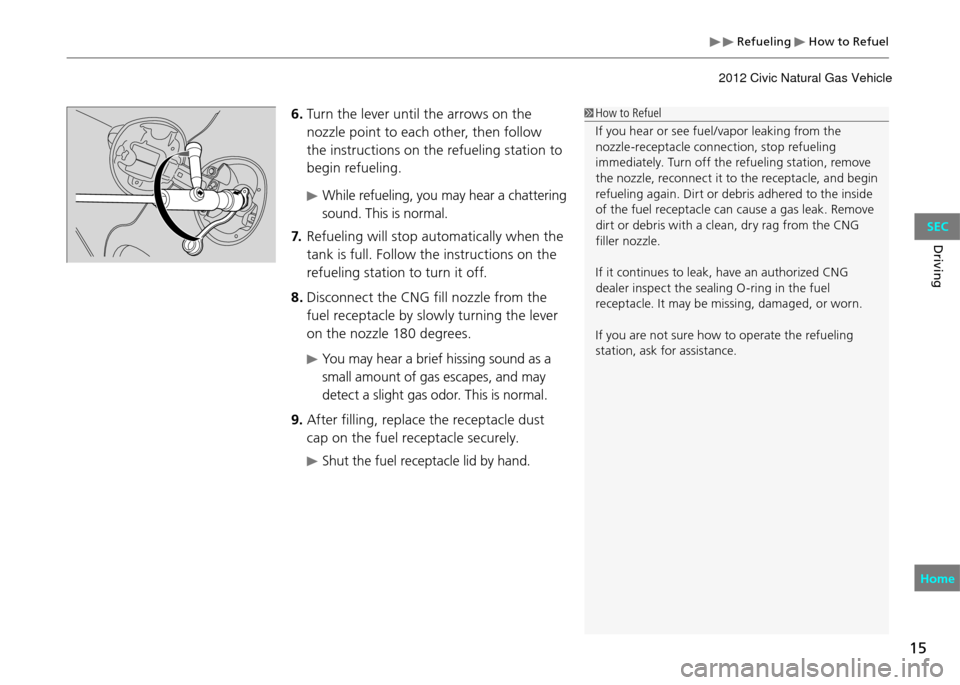
Refueling How to Refuel
15
Driving
How to Refuel
If you hear or see fuel/vapor leaking from the
nozzle-receptacle connection, stop refueling
immediately. Turn off the refueling station, remove
the nozzle, reconnect it to the receptacle, and begin
refueling again. Dirt or debris adhered to the inside
of the fuel receptacle can cause a gas leak. Remove
dirt or debris with a clean, dry rag from the CNG
filler nozzle.
If it continues to leak, have an authorized CNG
dealer inspect the sealing O-ring in the fuel
receptacle. It may be missing, damaged, or worn.
If you are not sure how to operate the refueling
station, ask for assistance.6. Turn the lever until the arrows on the
nozzle point to each other, then follow
the instructions on the refueling station to
begin refueling.
While refueling, you may hear a chattering
sound. This is normal.
7. Refueling will stop automatically when the
tank is full. Follow the instructions on the
refueling station to turn it off.
8. Disconnect the CNG fill nozzle from the
fuel receptacle by slowly turning the lever
on the nozzle 180 degrees.
You may hear a brief hissing sound as a
small amount of gas escapes, and may
detect a slight gas odor. This is normal.
9. After filling, replace the receptacle dust
cap on the fuel receptacle securely.
Shut the fuel receptacle lid by hand.
Home SEC
2012 Civic Natural Gas Vehicle
Page 16 of 33
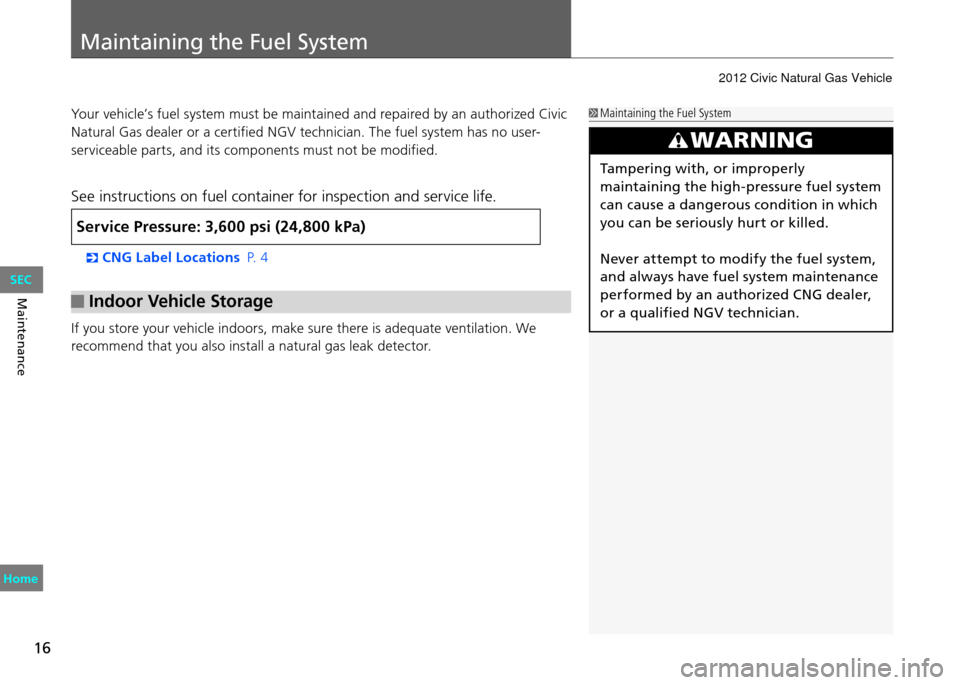
Maintaining the Fuel System
16
Maintenance
Your vehicle’s fuel system must be maintained and repaired by an authorized Civic
Natural Gas dealer or a certified NGV technician. The fuel system has no user-
serviceable parts, and its components must not be modified.
See instructions on fuel container for inspection and service life.
Maintaining the Fuel System
Service Pressure: 3,600 psi (24,800 kPa)
CNG Label Locations
P. 4
WARNING
Tampering with, or improperly
maintaining the high-pressure fuel system
can cause a dangerous condition in which
you can be seriously hurt or killed.
Never attempt to modify the fuel system,
and always have fuel system maintenance
performed by an authorized CNG dealer,
or a qualified NGV technician.
Indoor Vehicle Storage
If you store your vehicle indoors, make sure there is adequate ventilation. We
recommend that you also install a natural gas leak detector.
Home SEC
2012 Civic Natural Gas Vehicle
Page 17 of 33
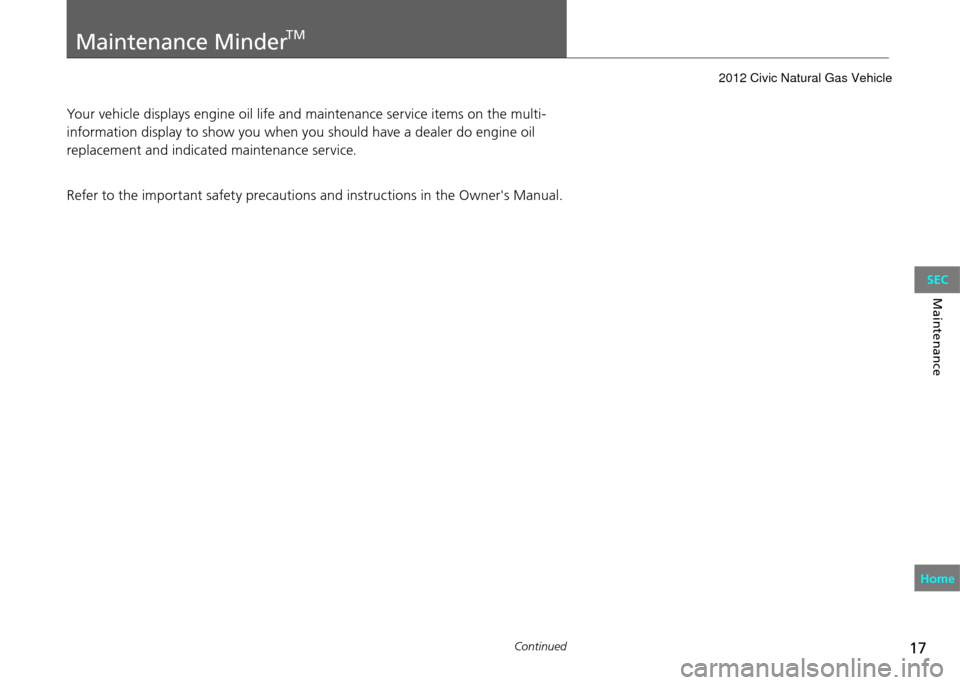
17Continued
Maintenance
Maintenance MinderTM
Your vehicle displays engine oil life and maintenance service items on the multi-
information display to show you when you should have a dealer do engine oil
replacement and indicated maintenance service.
Refer to the important safety precautions and instructions in the Owner's Manual.
HomeSEC
2012 Civic Natural Gas Vehicle
Page 18 of 33
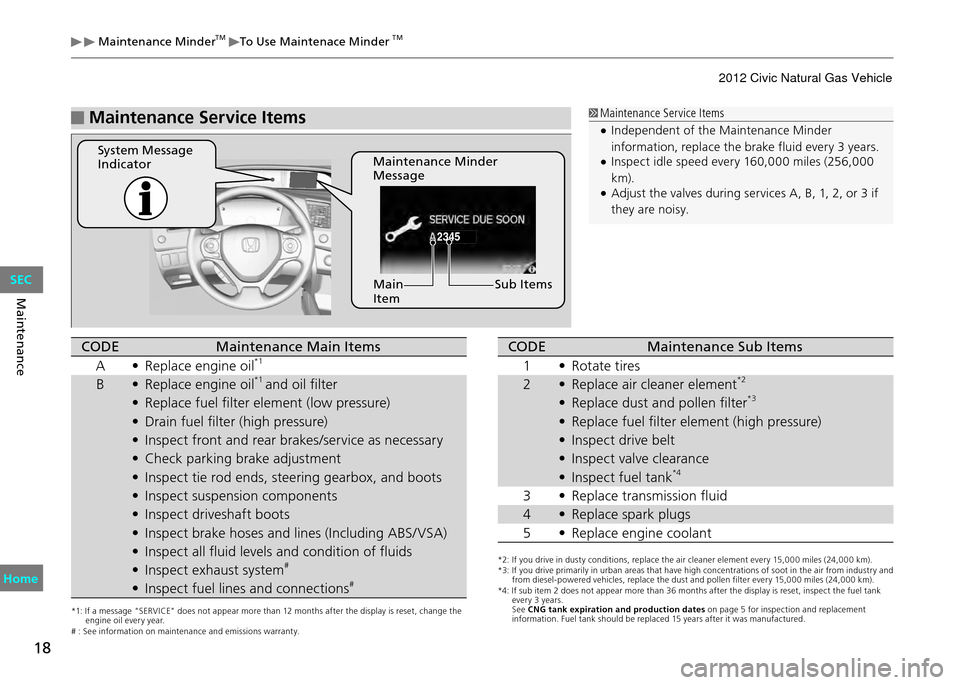
18
Maintenance
Maintenance MinderTM To Use Maintenace MinderTM
Maintenance Service Items
2345
Maintenance Service ItemsIndependent of the Maintenance Minder
•information, replace the brake fluid every 3 years.
Inspect idle speed every 160,000 miles (256,000
•km).
Adjust the valves during services A, B, 1, 2, or 3 if
•they are noisy.
CODE Maintenance Main Items
A Replace engine oil • *1
B Replace engine oil• *1 and oil filter
Replace fuel filter element (low pressure)
•
Drain fuel filter (high pressure)
•
Inspect front and rear brakes/service as necessary
•
Check parking brake adjustment
•
Inspect tie rod ends, steering gearbox, and boots
•
Inspect suspension components
•
Inspect driveshaft boots
•
Inspect brake hoses and lines (Including ABS/ VSA)
•
Inspect all fluid levels and condition of fluids
•
Inspect exhaust system
•
#
Inspect fuel lines and connections
• #
CODE Maintenance Sub Items
1 Rotate tires •
2 Replace air cleaner element •
*2
Replace dust and pollen filter
• *3
Replace fuel filter element (high pressure)
•
Inspect drive belt
•
Inspect valve clearance
•
Inspect fuel tank
•
*4
3 Replace transmission fluid •
4 Replace spark plugs •
5 Replace engine coolant •
*1: If a message "SERVICE" does not appear more than 12 months after the display is reset, change the
engine oil every year.
# : See information on maintenance and emissions warranty. *2: If you drive in dusty conditions, replace the air cleaner element every 15,000 miles (24,000 km).
*3: If you drive primarily in urban areas that have high concentrations of soot in the air from industry and
from diesel-powered vehicles, replace the dust and pollen filter every 15,000 miles (24,000 km).
*4: If sub item 2 does not appear more than 36 months after the display is reset, inspect the fuel tank
every 3 years.
See CNG tank expiration and production dates on page 5 for inspection and replacement
information. Fuel tank should be replaced 15 years after it was manufactured.
System Message
Indicator
Maintenance Minder
Message
Main
Item Sub Items
HomeSEC
2012 Civic Natural Gas Vehicle
Page 19 of 33
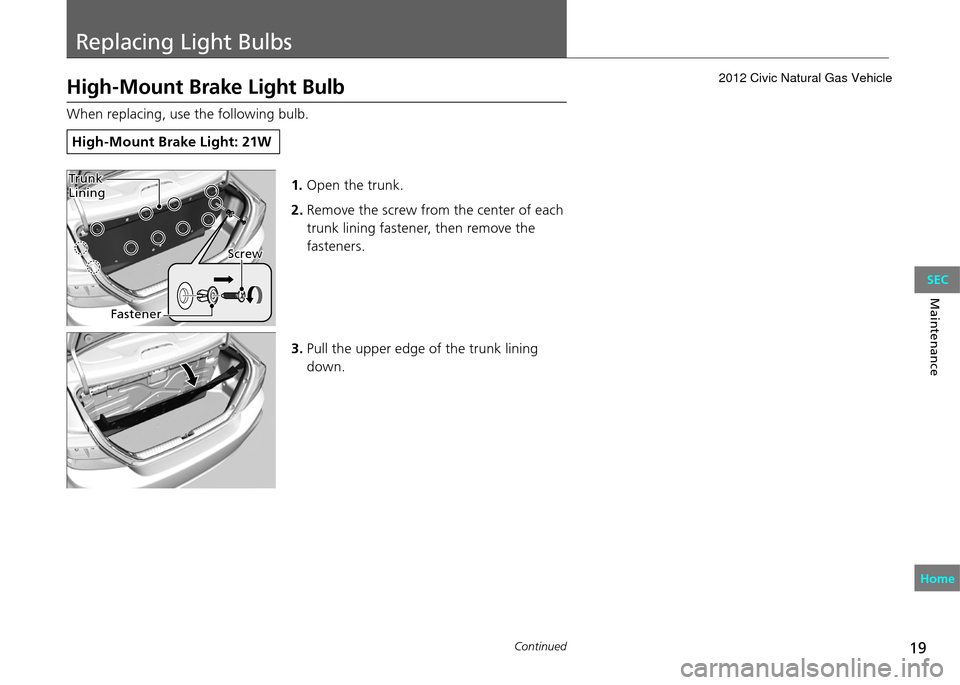
19
Replacing Light Bulbs
Continued
Maintenance
High-Mount Brake Light Bulb
When replacing, use the following bulb.
High-Mount Brake Light: 21W
1. Open the trunk.
2. Remove the screw from the center of each
trunk lining fastener, then remove the
fasteners.
3. Pull the upper edge of the trunk lining
down.Trunk Lining
Screw
Fastener
Home SEC
2012 Civic Natural Gas Vehicle
Page 20 of 33
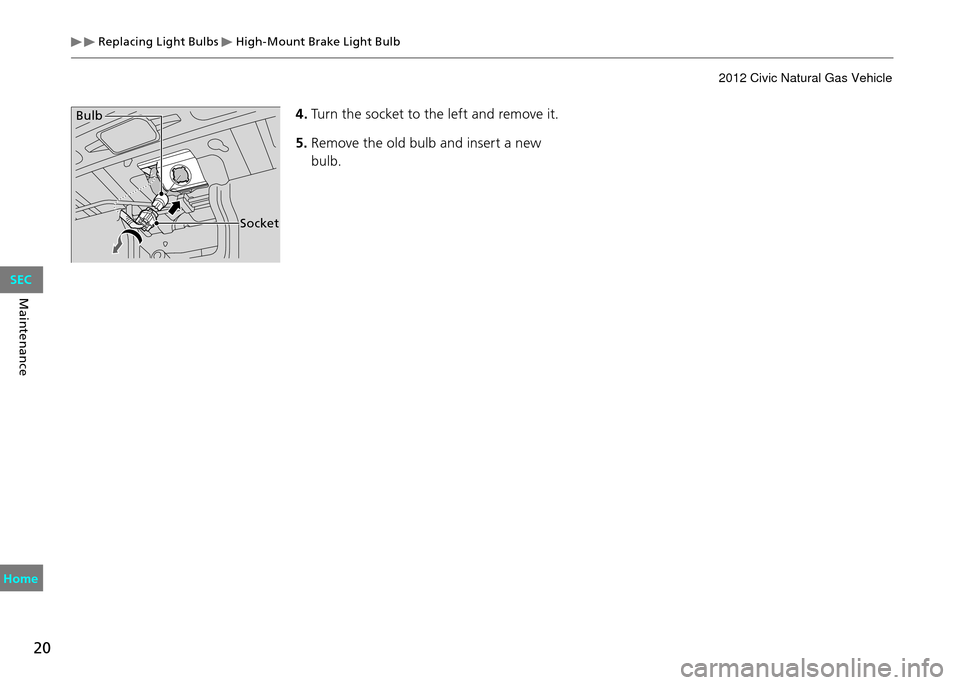
Replacing Light Bulbs High-Mount Brake Light Bulb
20
Maintenance
4. Turn the socket to the left and remove it.
5. Remove the old bulb and insert a new
bulb.Bulb
Socket
HomeSEC
2012 Civic Natural Gas Vehicle